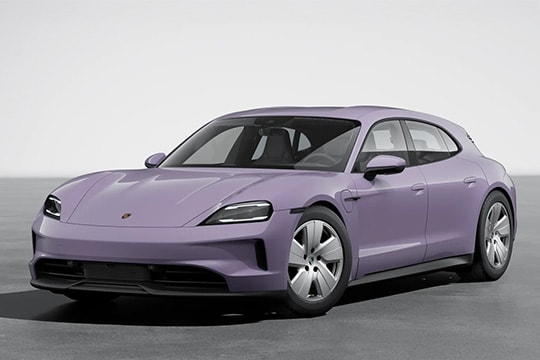Body style: Wagon (station wagon, estate, combi, touring)
Segment: Large
Infotainment: ![]() Apple CarPlay
Apple CarPlay ![]() Android Auto
Android Auto
Production years: 2024
 33 Photos
33 PhotosPorsche introduced the Taycan in 2019, and the car’s success on the market was so important that the German automaker considered creating a station wagon version of it named Sport Turismo.
Since there was an increased demand for EVs and after the Model Y from Tesla became the best-selling car in the world in 2023, Porsche considered launching the updated Taycan in early 2024. It refreshed the entire lineup, starting with the regular sedan-shaped version all the way to the Sport Turismo and the Cross Turismo. But it wasn’t just a mild update with some new colors and alloy wheels. While the exterior didn’t look that much different, the interior updates and the technology underneath the car’s skin were significant. As a result, customers could get a better vehicle that could run faster and travel further away, depending on the version they chose.
At the front, the Taycan Cross Turismo featured a revised fascia that included standard Matrix LED headlights. As an option, customers could get HD Matrix LEDs. The car also featured a new bumper that showed different side scoops. While on the initial version, these were visually linked to the headlights, in the 2024 model year, they were positioned lower. Another upgrade was noticed on the apron, which featured new trims on the lower air intake that helped cool the battery pack and the electronics.
From its profile, Porsche offered fewer surprises to its customers. The car had the same long roof and ended into a raked-forward tailgate. Despite being a station-wagon-shaped vehicle, it was not equipped with roof rails for external luggage. But still, there were some mild changes, such as new options for alloy wheels. At the back, the automaker offered the option for an illuminated logo, which was placed between the taillights.
Inside, customers could see and feel why the Taycan Cross Turismo was a premium sports vehicle. The upholstery for the lineup was made with high-quality materials, even from the base grades. The sports seats were standard, and between them, the automaker placed a narrow center console that housed an armrest with a storage area underneath, two cup holders, and the gear selector. The automaker kept the same touchscreen display tilted in front of the center console for the HVAC system. But the most significant upgrade in terms of technology was the infotainment system. It featured wireless Apple CarPlay that allowed more functions. As a result, customers didn’t have to exit CarPlay to make other car settings since they were integrated into the app. Unlike the regular Taycan, the Cross Turismo provided more headroom in the back thanks to its extended roof. The split-folding bench seat also allowed customers to expand the otherwise decently-sized trunk to a respectable 1,212 liters (42.8 cu-ft.).
Porsche also upgraded the drivetrain and the battery pack for the 2024 Taycan Cross Turismo. The base version came with a 94 kWh battery and more power for specific versions. It also introduced the active hydraulic suspension that allowed the vehicle to stay flat during high-speed cornering, accelerations, and brakes. Moreover, with an optional pack, the car could lean into the curves while driving fast to get better traction.
PORSCHE Taycan Sport Turismo 2024
- 105 KWh (435 HP)
PORSCHE Taycan Sport Turismo
105 KWh (435 HP)
ENGINE SPECS - 105 KWh (435 HP) | |
|---|---|
| Electrical motor power: | 319.9 kw (435 hp) |
| Electrical motor torque: | 309.8 lb-ft (420 Nm) |
| Fuel System: | Electric |
| Fuel: | Electric |
PERFORMANCE SPECS | |
|---|---|
| Top speed (electrical): | 143 mph (230 km/h) |
| Acceleration 0-62 Mph (0-100 kph): | 4.8 s |
TRANSMISSION SPECS | |
|---|---|
| Drive Type: | Rear Wheel Drive |
BRAKES SPECS | |
|---|---|
| Front: | Ventilated Discs |
| Rear: | Ventilated Discs |
DIMENSIONS | |
|---|---|
| Length: | 195.4 in (4963 mm) |
| Width: | 77.4 in (1966 mm) |
| Height: | 54.7 in (1389 mm) |
| Wheelbase: | 114.2 in (2901 mm) |
| Ground Clearance: | 5 in (127 mm) |
| Cargo Volume: | 15.8 cuFT (447 L) |
WEIGHT SPECS | |
|---|---|
| Unladen Weight: | 4751 lbs (2155 kg) |
| Gross Weight Limit: | 6107 lbs (2770 kg) |
POWER SYSTEM SPECS | |
|---|---|
| Power pack: | Lithium-Ion |
| Nominal Capacity: | 97 kWh |
| Maximum Capacity: | 105 kWh |
| Range: | 296.4 miles (477.0 km) |
| Notes |
|---|
| Power up to (HP) (Performance Battery Plus): 435 HP Power up to (HP): 408 HP Overboost performance with Launch Control up to (HP) (Performance Battery Plus): 435 HP Overboost performance at Launch Control up to (HP): 408 HP Maximum torque with Launch Control up to (Performance Battery Plus): 420 Nm Maximum torque with launch control up to: 410 Nm Maximum wheel torque with Launch Control up to (Performance Battery Plus): 6537 Nm Maximum wheel torque with launch control up to: 6381 Nm Combined power consumption (WLTP) (Performance Battery Plus): 20.9 - 17.9 kWh/100 km Combined power consumption (WLTP): 20.6 - 17.6 kWh/100 km Electricity consumption in urban areas (WLTP): 17.7 - 15.1 kWh/100 km Power consumption in urban areas (WLTP) (Performance Battery Plus): 16.4 - 14.4 kWh/100 km Combined range (WLTP) (Performance Battery Plus): 550 - 650 km Electric range in urban areas (WLTP) (Performance Battery Plus): 701 - 808 km Electric range in urban areas (WLTP): 553 - 650 km Gross energy content battery: 89 kwh Net energy content battery: 82.3 kWh |
































